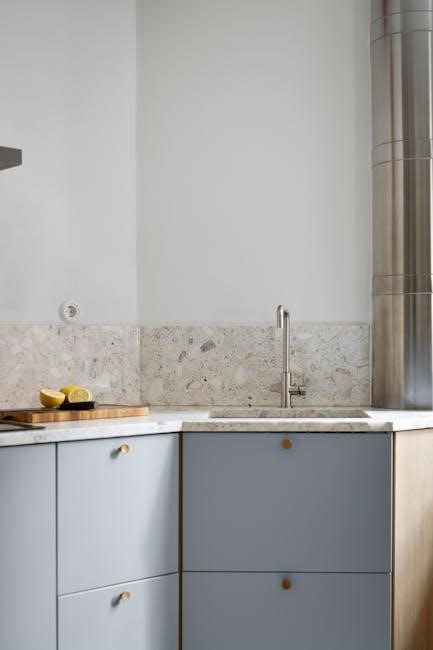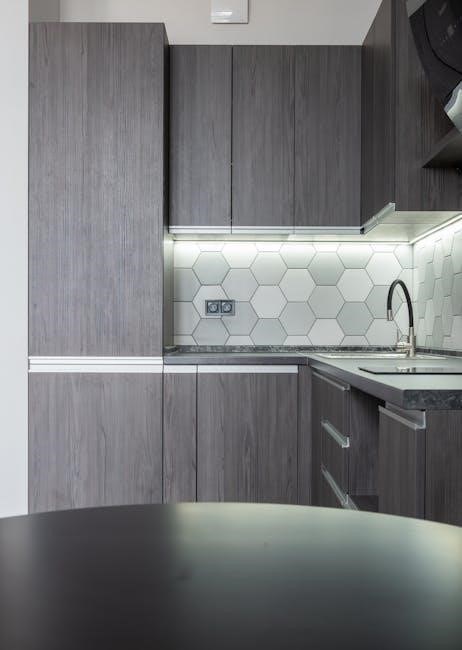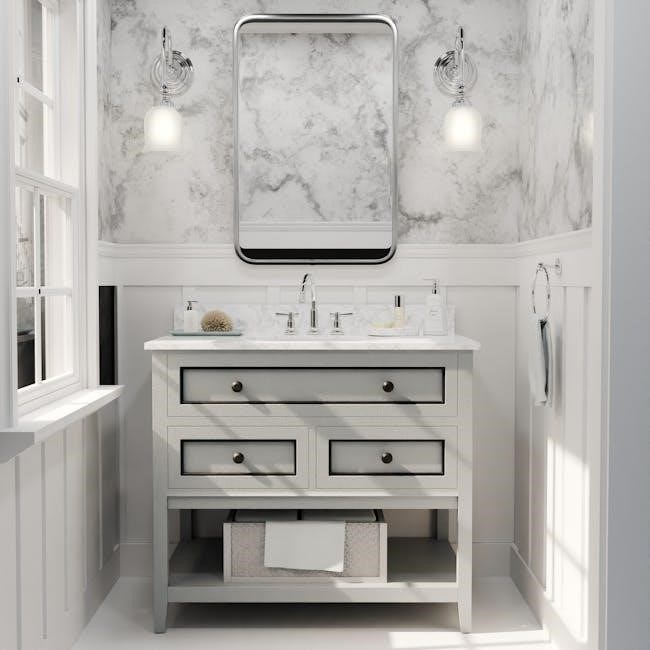Cabinet hardware transforms the look and functionality of spaces, offering essential components like knobs, pulls, hinges, and handles that enhance both form and function, making it vital for interior design․
Types of Cabinet Hardware
Cabinet hardware includes knobs, pulls, hinges, and handles, each serving functional and aesthetic purposes, with a wide range of styles and materials to suit various design preferences and needs․
2․1․ Knobs
Cabinet knobs are compact, versatile, and ideal for doors and smaller drawers․ They come in various styles, from classic to modern, offering a subtle yet functional design․ Knobs are often centered on doors for a balanced look and can be mixed with pulls for added visual interest․ Their size should complement the cabinet’s proportions, ensuring ease of use and aesthetic harmony․ Knobs are a timeless choice, blending seamlessly with any interior style․
2․2․ Pulls
Cabinet pulls are elongated handles that provide a comfortable grip, ideal for larger drawers and doors․ They come in various lengths and styles, offering a modern or contemporary look․ Pulls are typically placed 2․5 to 3 inches from the top or bottom edge, ensuring easy access and balanced aesthetics․ For wider drawers, two pulls are recommended for even weight distribution and enhanced functionality․ Their sleek design adds a polished touch to any cabinet setup․
2․3․ Hinges
Cabinet hinges are essential for smooth door operation, ensuring durability and quiet movement․ Common types include soft-close, concealed, and decorative hinges․ They are crucial for maintaining functionality and longevity, with options like adjustable hinges offering versatility․ Hinges should complement the cabinet’s style while providing reliable performance․ Proper installation ensures doors align correctly, enhancing both usability and aesthetics․ Durable materials like stainless steel or brass are popular choices, offering strength and corrosion resistance․
2․4․ Other Hardware Types
Beyond knobs and pulls, cabinet hardware includes latches, catches, and bin pulls, adding functionality and style․ Latches offer a rustic charm, while catches provide secure closure without visible hardware․ Bin pulls are ideal for large drawers, offering a sturdy grip․ These options enhance usability and aesthetics, allowing for personalized designs that suit various decor styles, from modern to traditional, ensuring versatility in kitchen or furniture projects․

How to Choose the Right Cabinet Hardware
Selecting cabinet hardware involves balancing style, functionality, and budget․ Consider the room’s decor, hardware types, and user needs to ensure a harmonious and practical result․
3․1․ Factors to Consider
When selecting cabinet hardware, consider the style, functionality, and durability․ Evaluate the room’s décor, personal preferences, and usage frequency․ Measure cabinet doors and drawers to ensure proper fit․ Think about the finish and material for consistency and longevity․ Budget is also crucial, as hardware costs can vary widely․ Lastly, assess ergonomic needs for comfort and ease of use․
3․2․ Budgeting Tips
Set a clear budget and prioritize needs over wants․ Research hardware prices to estimate costs per piece․ Consider bulk purchasing for discounts․ Start with essential hardware and gradually add decorative pieces․ Measure accurately to avoid waste․ Compare brands for quality and price balance․ Use online tools or templates for placement to reduce errors․ Invest in durable materials for long-term savings․ Plan ahead to stay within budget while achieving your design goals․
Cabinet Hardware Sizing Guide
The Cabinet Hardware Sizing Guide offers essential tips for optimal fit and functionality․ Measure drawer width and door height to choose appropriate sizes, ensuring comfort and style․ Always measure twice to avoid errors and ensure proper alignment for a polished look;
4․1․ Standard Sizes
Standard cabinet hardware sizes vary to suit different needs․ Knobs are typically 1-1․5 inches in diameter, while pulls range from 3-12 inches in length․ Small drawers often use single centered knobs or pulls, while larger drawers (over 30 inches wide) require two pulls for better grip and weight distribution․ Always choose sizes proportional to the cabinet or drawer size for a balanced and functional design․ Proper sizing ensures comfort and aesthetics․
4․2․ Measuring Tips
Accurate measurements are crucial for proper hardware placement․ Measure the width of drawers and doors to determine hardware size․ For pulls, place them 1/3 of the drawer width from the edge․ Knobs are often centered on doors․ Use a jig or template for precise alignment․ Test with a mockup to ensure comfort and aesthetics․ Measure twice and drill once to avoid errors․ This ensures a professional and functional result, enhancing both usability and design appeal․
Materials and Finishes
Cabinet hardware is crafted from durable materials like brass, stainless steel, and bronze․ Finishes such as polished nickel, matte black, and antique brass add style and longevity․
5․1․ Types of Materials
Cabinet hardware is available in various durable materials, including brass, stainless steel, bronze, and zinc․ Each material offers unique benefits, such as corrosion resistance or aesthetic appeal․ Brass is popular for its classic look, while stainless steel is prized for its modern, rust-free durability․ Bronze and zinc are also common, providing strength and versatility․ The choice of material depends on desired style, budget, and environmental conditions․
5․2․ Popular Finishes
Popular cabinet hardware finishes include polished nickel, matte black, brushed gold, and antique brass․ These finishes offer durability and style, complementing various design aesthetics․ Polished nickel and matte black are timeless choices, while brushed gold adds a modern touch․ Antique brass provides a vintage look, blending seamlessly with traditional designs․ Each finish enhances both functionality and visual appeal, ensuring a cohesive look for any space․
Functionality vs․ Aesthetics
Balancing functionality and aesthetics in cabinet hardware is crucial․ Aesthetic choices enhance visual appeal, while functionality ensures usability and durability, blending style with practicality․
6․1․ Prioritizing Functionality
Functionality is the foundation of cabinet hardware selection․ Ensure ease of use and durability by choosing hardware that complements your lifestyle․ For instance, pulls are ideal for large drawers, offering a firm grip, while knobs are perfect for smaller doors․ Consider the frequency of use and weight distribution to prevent wear and tear․ Placement should align with natural hand movement for comfort and accessibility, ensuring practicality without compromising design․
6․2․ Emphasizing Aesthetics
Aesthetic considerations play a crucial role in selecting cabinet hardware, as it enhances the visual appeal of your space․ Choose hardware that complements your interior style, whether modern, traditional, or minimalist․ Consider finishes like polished nickel or matte black for a cohesive look․ Mixing hardware types, such as knobs and pulls, adds layered interest, while scale ensures proportionality with cabinet size for a polished, designer appearance․
Cabinet Hardware Placement Guide
7․1․ Placement on Doors
Knobs are typically placed 2․5 to 3 inches from the top or bottom edge of cabinet doors, centered horizontally․ Aligning hardware with the face frame ensures symmetry and ease of use, enhancing both functionality and visual appeal․
For cabinet doors, hardware placement typically follows standard measurements to ensure functionality and aesthetic balance․ Knobs are often positioned 2․5 to 3 inches from the top or bottom edge, centered horizontally․ This placement aligns with the face frame, creating symmetry and ease of use․ Proper alignment enhances both the visual appeal and practicality of the hardware, making it a key consideration in cabinet design․
7․2․ Placement on Drawers
Drawer hardware placement depends on size and style․ Small drawers often feature a single centered knob or pull, while larger drawers (over 30 inches wide) typically require two pulls for better grip and weight distribution․ The hardware is usually positioned 2․5 to 3 inches from the top or bottom edge, ensuring ergonomic access and visual balance․ This placement enhances functionality and design consistency across the space․
7․3․ Upper vs․ Lower Cabinets
Hardware placement varies between upper and lower cabinets․ Upper cabinets often feature smaller knobs or pulls, positioned 2․5 to 3 inches from the bottom edge for easy access․ Lower cabinets typically use larger pulls, placed 2․5 to 3 inches from the top edge, ensuring comfort and functionality․ This differentiation supports ergonomic design while maintaining visual harmony and practicality in the kitchen or bathroom space․
Installation Tools and Tips
Essential tools for cabinet hardware installation include a hardware jig, drill, level, and measuring tape․ Pre-drill holes and align hardware precisely for a professional finish․
8․1․ Essential Tools
For a successful cabinet hardware installation, gather essential tools: a cabinet hardware jig, drill, level, screwdriver, measuring tape, and clamps․ The jig ensures precise alignment, while the level guarantees straight placement․ A drill is necessary for pre-drilling holes, and a screwdriver secures the hardware․ Measuring tape helps accurate positioning, and clamps keep surfaces stable․ These tools collectively ensure a professional and error-free installation process․
8․2․ Step-by-Step Installation
Begin by measuring and marking hardware positions using a jig for accuracy․ Pre-drill screw holes to avoid damaging the cabinet surface․ Align the hardware with the marks, ensuring it’s level․ Secure the hardware with screws, tightening firmly․ Double-check the alignment and functionality․ For pulls, attach both screws evenly․ Ensure all hardware operates smoothly and is visually consistent․ This method guarantees a precise and professional installation every time․
Styling Tips for Cabinet Hardware
Mix hardware types for layered interest, like combining knobs and pulls․ Ensure finishes align with your space’s style for a cohesive look․ Scale matters—choose hardware proportional to cabinet size․ Placement should balance aesthetics and functionality, enhancing your design seamlessly․
9․1․ Mixing Hardware Types
Mixing cabinet hardware types adds visual interest and functionality․ Combine knobs, pulls, and latches for a layered look․ Knobs work well on doors, while pulls suit drawers․ Ensure finishes and styles align for a cohesive design․ This approach balances aesthetics and practicality, enhancing your space’s overall appeal while maintaining usability․
9․2․ Coordinating with Style
Coordinating cabinet hardware with your space’s style ensures a harmonious design․ Match finishes like polished nickel or matte black to existing fixtures․ Consider the era—modern spaces suit sleek pulls, while traditional settings favor ornate knobs․ Aligning hardware with your style creates a cohesive look, enhancing both functionality and aesthetics for a polished, professional result․

Trends in Cabinet Hardware
Current trends in cabinet hardware emphasize minimalist designs, bold finishes, and smart technology integration, allowing for a blend of modern aesthetics and functional innovation in homes․
10․1․ Current Trends
Modern cabinet hardware trends highlight sleek, minimalist designs with bold finishes like matte black, gold, and brushed nickel․ Smart technology integration, such as touch-to-open mechanisms, is gaining popularity․ Mixing hardware types, like knobs and pulls, adds layered interest, while oversized pulls create a contemporary look․ Sustainability and ergonomic designs are also influencing current choices, blending style with functionality seamlessly․
10․2․ Future Predictions
Future cabinet hardware trends may focus on advanced smart technology, such as voice-activated or app-controlled systems․ Sustainable materials like recycled metals and eco-friendly finishes are expected to rise in popularity․ Larger, statement-making hardware could emerge as a design trend, blending functionality with bold aesthetics․ Personalized and customizable options may also dominate, allowing homeowners to tailor hardware to their unique styles and preferences seamlessly․

Common Mistakes to Avoid
Common mistakes include incorrect hardware placement, inconsistent finishes, and improper sizing, which can affect functionality and aesthetics․ Avoid these errors for a polished, professional look․
11․1․ Mistakes
Common mistakes include mixing hardware types without a cohesive plan, using inconsistent finishes, and incorrect placement that disrupts functionality․ Oversizing or undersizing hardware can throw off proportions, while ignoring ergonomics leads to discomfort․ Additionally, overloading with too many styles can create visual clutter, and neglecting durability for low-quality options often results in premature wear․
11․2․ Solutions
To avoid mistakes, plan hardware selection with a cohesive style in mind․ Stick to a consistent finish and ensure hardware is proportional to cabinet size․ Use placement guides or templates for accuracy and ergonomics․ Limit hardware variety to 2-3 styles for a balanced look․ Finally, invest in durable materials to ensure longevity and functionality, addressing both aesthetic and practical needs effectively․
Care and Maintenance
Regularly clean hardware with a soft cloth and gentle cleaner to prevent tarnish․ Avoid harsh chemicals and abrasive materials that may damage finishes․ Dust frequently to maintain shine and functionality, ensuring long-lasting performance and aesthetic appeal of your cabinet hardware․
12․1․ Cleaning
For optimal maintenance, clean cabinet hardware regularly using a soft, dry cloth to remove dust and fingerprints․ For tougher stains, mix mild soap with warm water, dip a cloth, and gently wipe․ Avoid harsh chemicals or abrasive materials that can damage finishes․ For polished or metallic surfaces, use a specialized metal cleaner to preserve shine and prevent tarnish․ Regular cleaning ensures hardware remains functional and visually appealing․
12․2․ Maintenance
Regular maintenance ensures cabinet hardware remains durable and functional․ Lubricate hinges periodically to prevent squeaking and wear․ Inspect screws and tighten them if loose to maintain stability․ For scratches or tarnish, use touch-up solutions designed for your hardware’s finish․ Avoid using abrasive materials or harsh chemicals, as they can damage surfaces․ Proper upkeep extends the lifespan of your hardware, keeping it both functional and visually appealing over time․
Selecting and installing cabinet hardware is a crucial step in enhancing both the functionality and aesthetics of any space․ By understanding your needs, budget, and style, you can choose hardware that complements your design while ensuring durability․ Proper placement, sizing, and maintenance are key to long-term satisfaction․ With the right hardware, your cabinets become not only functional but also a statement piece in your home․

Additional Resources
Explore detailed guides, tools, and communities for further insight into cabinet hardware․ Websites like Van Dykes and True Position Tools offer comprehensive resources, including placement guides and sizing charts․ Online forums and design communities provide inspiration and troubleshooting tips․ For hands-on projects, consider hardware jigs and adjustable drill guides for precise installations․ These resources empower you to make informed decisions and achieve professional-grade results in your cabinet hardware projects․
Final Thoughts
Selecting the right cabinet hardware is a blend of style, functionality, and personal preference․ By considering factors like material, finish, and placement, you can elevate your space seamlessly․ Remember, hardware is both decorative and functional, so choose pieces that reflect your unique taste while ensuring ease of use․ With the insights from this guide, you’re equipped to make informed decisions and create a cohesive, beautiful design that enhances your home’s aesthetic and usability․
